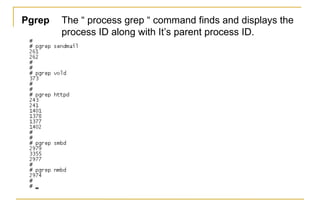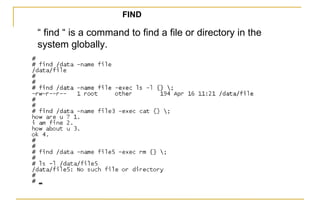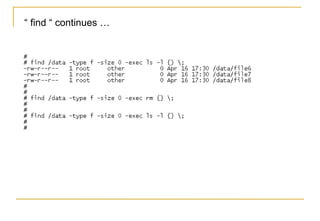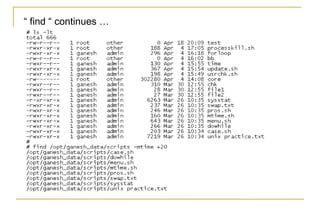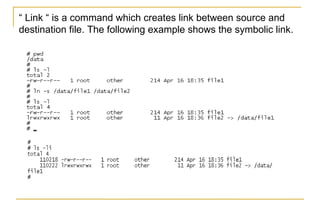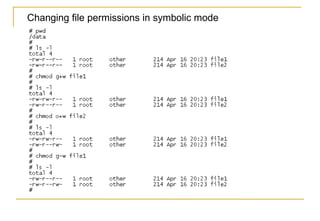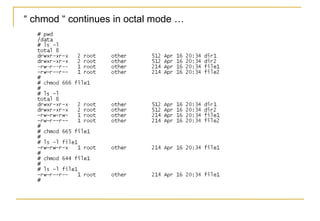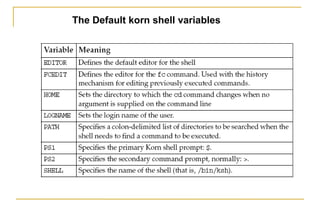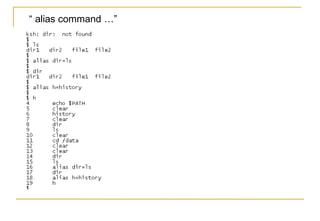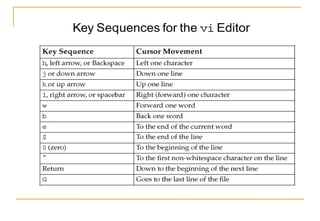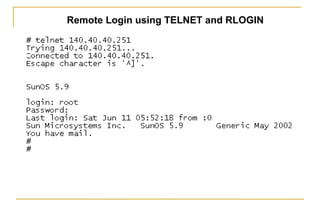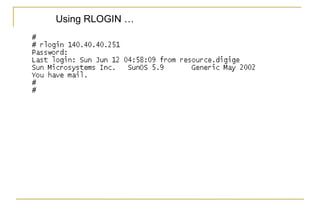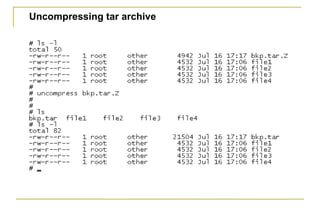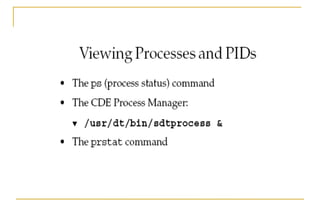Unix commands
- 1. Unix Fundamentals and command references Solaris Linux HP-UX AIX
- 2. Commands
- 3. uname - It shows system identification information
- 4. showrev - System information with Host ID
- 5. # pwd – It shows the present working directory
- 7. ls - List of directories and files
- 8. ls continues
- 10. cal - It shows calendar
- 11. date - it shows the current date Date format : mm dd hh mm yy . s
- 12. mkdir – to create a new directory
- 13. cd - to change the directory
- 14. rmdir or rm –r - to remove the directory mv – move or rename the directory or file
- 15. mv continues … ( if destination directory already exists “ mv “ moves source directory to destination directory ).
- 16. cp - It copies directories and files from one location to another location. “ cp “command copies only files from one location to another location. “ cp - r “ Can be used to copy directories.
- 17. “ cat “ command is used to create or read the contents of the files. To append some more content with the existing file “ >> “ can be used.
- 18. “ file “ is a command which tells you the property of file or Directory.
- 19. “ more “ command displays the file contents page wise.
- 20. “ less “ command displays the file content like “ more “ command but, it has to be closed with “ q “.
- 21. “ touch “ is the command which creates zero length files or it puts time stamp on the file or files which are already exist.
- 22. “ head “ command displays the file contents with “ – “option
- 23. “ tail “ command displays file contents like “ head “ with “ - , + “ option.
- 24. “ sort “ command displays file contents in ascending and descending order.
- 25. “ wc - word count “ command displays words, lines, chars, bytes, mem size and all.
- 26. “ which “ command shows the location of the commands, which are set in environment variable “ PATH “
- 27. “ df – Disk free “ command shows the disk space level
- 28. “ clear “ command clears the screen
- 29. “ tty “ the terminal command shows the pseudo terminals.
- 30. “ echo “ command show the given value or shows the value of the environment varriables.
- 31. “ grep “ is the command which displays the line with the matching pattern. It can be executed with more options. Option Definition -i Searches for both uppercase and lowercase characters -l Lists the names of files with matching lines -n Precedes each line with the relative line number in the file -v Inverts the search to display lines that do not match the pattern -c Counts the lines that contain the pattern -w Searches for the expression as a complete word, ignoring those matches that are substrings of larger words.
- 32. The “ grep “ command supports several regular expression Meta characters to further define a search pattern. This table describes some of the regular expression meta characters. Regular expression meta characters: Metacharacter Purpose Example Result ^ Beginning of ’^pattern’ Matches all lines line anchor beginning with “pattern” $ End of line ’pattern$’ Matches all lines anchor ending with “pattern”
- 33. Additional regular expression meta characters: Metacharacter Purpose Example Result Matches one ’p.....n’ Matches lines . character containing a “p,” followed by Five characters, and followed by an “n” Matches the ’[a-z]*’ Matches * preceding Lowercase item zero or Alphanumeric more times characters or nothing at all
- 34. “ grep “ continues … Metacharacter Purpose Example Result Matches one Matches lines character in ’[Pp]attern’ Containing [] “Pattern” or the pattern “pattern” Matches one Matches lines that character not do not contain “a” [^] ’[^am] in the pattern through “m” and attern’ followed by“attern”
- 35. “ grep “ continues …
- 36. “ grep “ continues ….
- 37. “ grep “ continues ..
- 38. “ grep “ continues ..
- 39. “ grep “ continues ….
- 40. “ grep “ continues….
- 41. “ grep “ continues …
- 42. Egrep The egrep command searches the contents of one or more files for a pattern using extended regular expression metacharacters. Extended regular expression metacharacters include the regular expression metacharacters that the grep command uses, plus some additional metacharacters.
- 43. Egrep Metacharacter Purpose Sample Result + Matches one or ’[a-z]+ark’ Matches one or more more of the lowercase letters preceding followed by “ark” (for characters example, “airpark,” “bark,” “dark,” “landmark,” “shark,” “sparkle,” “trademark”) ? Matches zero ‘patte[r?]’ Matches lines or one Containing the literal character character or metacharacter it follows x|y Matches either x or ’apple | orange’ Matches for either y expression
- 44. “ egrep Example :
- 45. “ egrep “ continues…
- 46. “ egrep continues …
- 47. Pgrep The “ process grep “ command finds and displays the process ID along with It’s parent process ID.
- 48. FIND “ find “ is a command to find a file or directory in the system globally.
- 49. “ find “ continues …
- 50. “ find “ continues …
- 51. “ find “ continues …
- 52. “ find “ continues ..
- 53. “ w “ is a command which shows the particular user’s Information in an elaborate manner.
- 54. “ SU “ command can be used to switch over from one user to an other user physically.
- 55. “ who “ command shows a respective user’s information
- 56. “ who “ continues …
- 57. “ id “ command shows user’s ID and primary group ID
- 58. “ finger “ command displays the user information along with user’s status
- 59. “ Link “ is a command which creates link between source and destination file. The following example shows the symbolic link.
- 60. “ Hard Link “ creates link between source and destination.
- 68. Changing file permissions in symbolic mode
- 69. “ chmod “ continues …
- 70. “ chmod “ continues in octal mode …
- 71. “ chmod “ continues in octal mode…
- 73. “ umask “ continues …
- 74. Korn Shell
- 75. The Default korn shell variables
- 76. Customizing Korn Shell Variable To change the shell environment from Bourn shell to Korn shell :
- 77. To change the prompt .. To change the prompt variable…
- 78. “ History command …
- 79. “ alias command …”
- 80. Using VI Editor Identifying the Fundamentals of vi Editor operation • Introducing the vi editor modes of operation • The command mode • The edit mode • The last line mode • Switching between the command and edit modes • Introducing the vi command
- 90. Remote Login using TELNET and RLOGIN
- 91. Using RLOGIN …
- 92. File Archives tar -c - to create tar archive -v - to get verbose -f - the out put device or directory -t - table of contents -x - extract from the tar archive
- 93. To create tar archive Example To see the table of content
- 94. To extract from the tar archive
- 95. Compress To compress the tar archive
- 96. Example for compress archive
- 98. gzip To create gzip archive
- 99. To extract the tar archive by gunzip
- 100. Unix Administration Solaris
- 101. Solaris User Administration Each user account consists of five main components: • User name • Password • User’s home directory • User’s login shell • User initialization files
- 102. Managing User Accounts Before you can add user accounts to the system, you must determine the following information for each new user: • Login name • User identification (UID) number • Group identification (GID) number • Comment • home directory • Login shell • Password aging
- 103. Storing User and Group Account information The Solaris Operating Environment stores user account and group account information in the following system files: • /etc/passwd – Authorized system users have login account entries in the /etc/passwd file. • /etc/shadow – All passwords are encrypted and maintained in a separate shadow file named /etc/shadow. • /etc/group – The /etc/group file defines the default system group accounts.
- 104. The “ /etc/passwd “ file format root:x:0:1:Super-User:/:/sbin/sh daemon:x:1:1::/: bin:x:2:2::/usr/bin: sys:x:3:3::/: adm:x:4:4:Admin:/var/adm: lp:x:71:8:Line Printer Admin:/usr/spool/lp: smtp:x:0:0:Mail Daemon User:/: uucp:x:5:5:uucp Admin:/usr/lib/uucp: nuucp:x:9:9:uucp Admin:/var/spool/uucppublic:/usr/ lib/uucp/uucico listen:x:37:4:Network Admin:/usr/net/nls: nobody:x:60001:60001:Nobody:/: noaccess:x:60002:60002:No Access User:/: nobody4:x:65534:65534:SunOS 4.x Nobody:/:
- 105. The “ /etc/shadow “ file format root:LXeoktCoMtwZN:6445:::::: daemon:NP:6445:::::: bin:NP:6445:::::: sys:NP:6445:::::: adm:NP:6445:::::: lp:NP:6445:::::: smtp:NP:6445:::::: uucp:NP:6445:::::: nuucp:NP:6445:::::: listen:*LK*::::::: nobody:NP:6445:::::: noaccess:NP:6445:::::: nobody4:NP:6445::::::
- 106. The “ /etc/group “ file format root::0:root other::1: bin::2:root,bin,daemon sys::3:root,bin,sys,adm adm::4:root,adm,daemon uucp::5:root,uucp mail::6:root tty::7:root,tty,adm lp::8:root,lp,adm nuucp::9:root,nuucp staff::10: daemon::12:root,daemon sysadmin::14:lister,torey nobody::60001: noaccess::60002: nogroup::65534:
- 107. Command line User Account Administration The following command-line tools add, modify, and delete user accounts and group accounts on the local system: • useradd – Adds a new user account • usermod – Modifies a user’s account • userdel – Deletes a user’s account • groupadd – Adds (creates) a new group account • groupmod – Modifies a group account • groupdel – Deletes a group account
- 109. Example :
- 111. Example :
- 113. Example :
- 115. Example :
- 117. Example :
- 119. Example :
- 123. Viewing current process status
- 125. Administering the active process

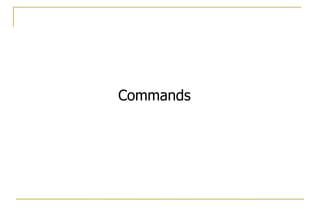

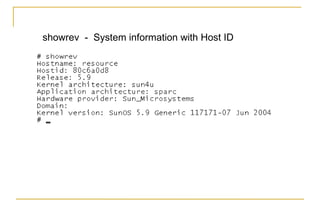
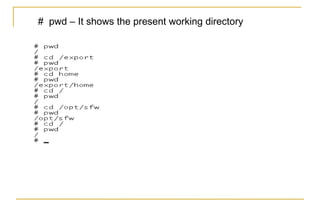


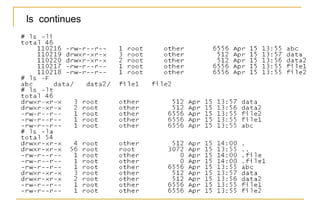
















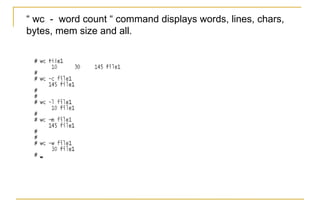




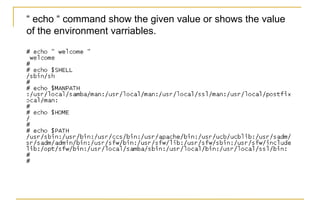


![Additional regular expression meta characters:
Metacharacter Purpose Example Result
Matches one ’p.....n’ Matches lines
.
character containing a
“p,” followed by
Five characters,
and followed
by an “n”
Matches the ’[a-z]*’ Matches
*
preceding Lowercase
item zero or Alphanumeric
more times characters or
nothing at all](https://image.slidesharecdn.com/unixcommands-120412032551-phpapp01/85/Unix-commands-33-320.jpg)
![“ grep “ continues …
Metacharacter Purpose Example Result
Matches one Matches lines
character in ’[Pp]attern’ Containing
[] “Pattern” or
the pattern
“pattern”
Matches one Matches lines that
character not do not contain “a”
[^] ’[^am]
in the pattern through “m” and
attern’ followed by“attern”](https://image.slidesharecdn.com/unixcommands-120412032551-phpapp01/85/Unix-commands-34-320.jpg)





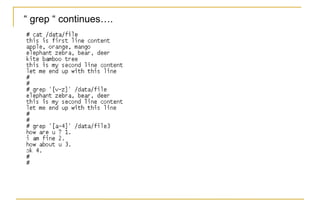


![Egrep
Metacharacter Purpose Sample Result
+ Matches one or ’[a-z]+ark’ Matches one or more
more of the lowercase letters
preceding followed by “ark” (for
characters example, “airpark,”
“bark,” “dark,”
“landmark,” “shark,”
“sparkle,” “trademark”)
? Matches zero ‘patte[r?]’ Matches lines
or one Containing the literal
character character or
metacharacter it
follows
x|y Matches either x or ’apple | orange’ Matches for either
y expression](https://image.slidesharecdn.com/unixcommands-120412032551-phpapp01/85/Unix-commands-43-320.jpg)



